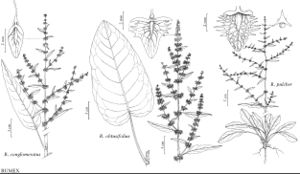Rumex conglomeratus
Prodr. Stirp. Gott., 52. 1770.
Plants perennial, normally glabrous, rarely very indistinctly papillose on veins of leaf-blades abaxially, with fusiform, vertical rootstock. Stems erect, branched in distal 2/3 (sometimes with few flowering-stems from rootstock), 30–80 (–120) cm. Leaves: ocrea deciduous to partially persistent at maturity; blade oblong-lanceolate, obovate-lanceolate, or lanceolate, normally (5–) 10–30 × 2.5–6 cm, base broadly cuneate, rounded, or truncate, rarely subcordate, margins entire, flat to very weakly undulate, apex subacute, occasionally obtuse. Inflorescences terminal, occupying distal 2/3 of stem, lax, interrupted, broadly paniculate, branches simple or nearly so, almost all but distalmost whorls with subtending leaves; panicle leafy at least in proximal 2/3 of length. Pedicels articulated in proximal 1/3 or occasionally near middle, filiform, 1–4 (–5) mm, ca. as long as inner tepals or slightly longer, articulation distinctly swollen. Flowers 10–20 in dense remote whorls; inner tepals oblong-lanceolate, oblong, or lingulate, 2–3 × 1–1.6 (–2) mm, ca. 2 times as long as wide, base cuneate or truncate, margins entire, apex obtuse; tubercles 3, equal or subequal, largest tubercle almost as wide as inner tepal. Achenes usually dark reddish-brown, 1.5–1.8 × 1–1.4 mm. 2n = 20.
Phenology: Flowering early summer–early fall.
Habitat: Marshes, wet meadows, shores, alluvial woods, ditches, wet waste places
Elevation: 0-1500 m
Distribution

Introduced; B.C., Ala., Ariz., Ark., Calif., Ga., Ill., Ind., Ky., La., Mass., Miss., Mo., N.Y., N.C., Okla., Oreg., Pa., S.C., Tenn., Tex., Va., Wash., W.Va., Europe, w, sw Asia, n Africa, elsewhere
Discussion
Rumex conglomeratus often is confused with immature specimens of R. obtusifolius, as well as with other species (e.g., R. sanguineus). Its distribution in North America is insufficiently known, and some literature records may refer to R. obtusifolius.
Rumex conglomeratus and R. sanguineus were placed in subsect. Conglomerati Rechinger f. (K. H. Rechinger 1937).
Selected References
None.
Lower Taxa
"/2" is not declared as a valid unit of measurement for this property.
